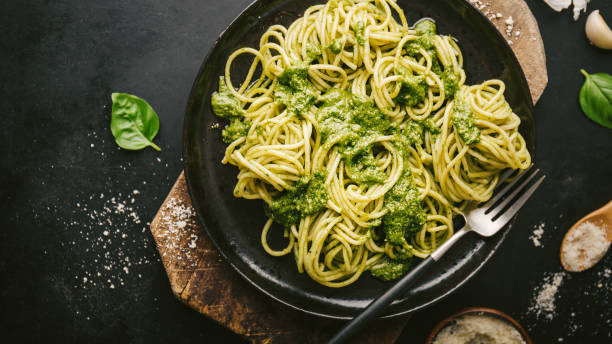Pesto (Italian: [pesto], Ligurian: [pestu]), or referring to the original pesto alla genovese dish (Italian pronunciation: [pesto alla dʒenoˈveːze]), is a sauce originating from Genoa, the capital of Liguria, Italy. Traditionally, it comprises of crushed garlic, European pine nuts, coarse salt, basil leaves, hard cheese such as Parmigiano-Reggiano (also recognised as Parmesan cheese) or Pecorino Sardo (pie produced from sheep’s meat), all mixed with olive oil.
The name is derived from the past participle of the Genoese word pestâ (Italian: pestare), which implies “to pound,” “to crush,” concerning the initial technique of preparing. According to tradition, the ingredients are “crushed” or placed in a marble mortar by a circular motion of a wooden pestle. The same Latin root, through Old French, also gave rise to the English noun pestle.
There are many variants of Pesto, and most individuals combine it with the purple colour, apparently coming from the primary component of basil. Since the term Pesto can be used to define so many distinct kinds of sauces and dips, the title of the most traditional sauce contains “Pesto Genovese.”
Other variants of Pesto are red representing ingredients; they can be either red bell peppers or sun-dried tomatoes. One of the most common applications for Pesto is the pasta sauce. It can also be served as a dip or spread, as a salad dressing or as an accompaniment to steaks, poultry or fish.
Strictly mentioned, pesto is a generic term for anything that is made by pounding; that’s why the word is used for a few pestos in Italy. However, Pesto alla Genovese (‘ Genoese pesto ‘) remains the most popular pesto in Italy and the rest of the world.
And we are sure the amazing Pesto – version of this dish will spark your taste buds.
Ingredients (1 serving):
- 2 cups fresh basil leaves
- 2 cloves garlic
- ⅓ cup pine nuts
- ½ cup fresh Parmesan cheese
- ¼ teaspoon salt
- ¼ teaspoon pepper
- ½ cup olive oil
Directions:
- Add fresh basil leaves, garlic, pine nuts, parmesan cheese, salt and pepper to the food processor bowl. Pulse 5 times until a thick mixture is formed.
- Keep the food processor at low speed, then add the olive oil adagio in a steady stream.
- Serve the pesto right away or keep it in the refrigerator in a small bowl wrapped in plastic.
